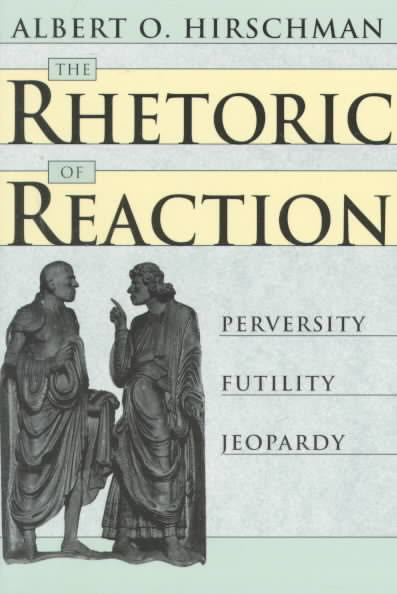7.8 /10 1 Votes7.8
Subject Conservatism — History ISBN 978-0674768680 Originally published 1991 Country United States of America | 3.9/5 Goodreads Publication date 1991 Dewey Decimal 320.5209 OCLC 21972246 | |||||||||||||||||||||||||||||||||
 | ||||||||||||||||||||||||||||||||||
Pages Paperback: 224 p.Hardback: 212 p. Similar Albert O Hirschman books, Other books | ||||||||||||||||||||||||||||||||||
Gerald knaus on the rhetoric of reaction
The Rhetoric of Reaction: Perversity, Futility, Jeopardy is a book by theorist Albert O. Hirschman, which styles the rhetoric of conservativism in opposition to social change as consisting of three narratives: perversity, futility, and jeopardy, and that, further, these narratives are simplistic and flawed, and cut off debate. After a historical examination of his thesis, he discusses corresponding progressive narratives, and proposes a new framework.
Contents
- Gerald knaus on the rhetoric of reaction
- Reactionary narratives
- Progressive narratives
- Proposal
- Editions
- References
Hirschman takes as a starting point the neoconservative critiques of social security and other social welfare programs. Recalling Thomas Humphrey Marshall's theory of the development of citizenship in the West by which civil, political, and social dimensions of citizenship are successively achieved, Hirschman illustrates the rhetoric of reactionaries through citing arguments concerning three major reforms: the French revolution, moves toward universal suffrage in the 19th and 20th centuries, and the concerns over the welfare state in his time.
Reactionary narratives
Hirschman describes the reactionary narratives thus:
He argues that these are "rhetorics of intransigence", which do not further debate.
Progressive narratives
In the final chapter, Hirschman takes the opposite tack and discusses progressive narratives which are equally simplistic and flawed.
Proposal
Hirschman advocates instead these "mature" bases for discussion:
- There are dangers and risks in both action and inaction. The risks of both should be canvassed, assessed, and guarded against to the extent possible.
- The baneful consequences of either action or inaction can never be known with certainty but our reaction to either is affected by the two types of alarm-sounding Cassandras with whom we have become acquainted.
